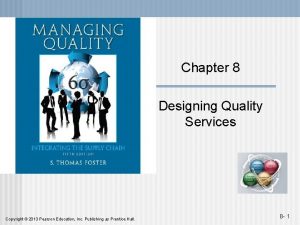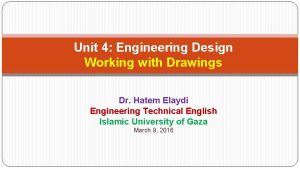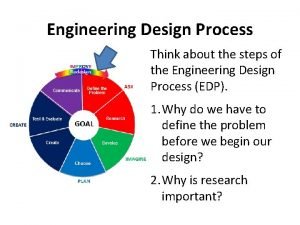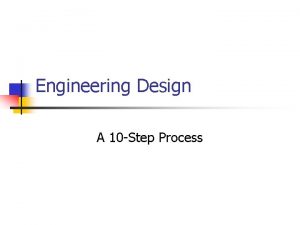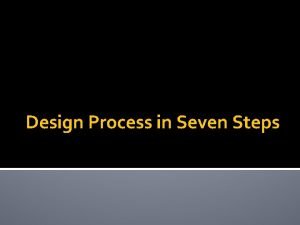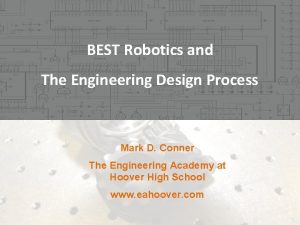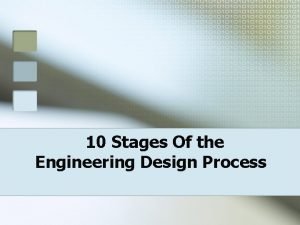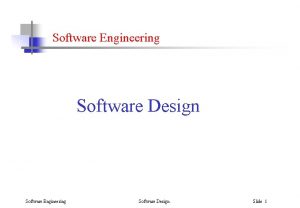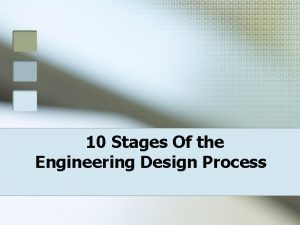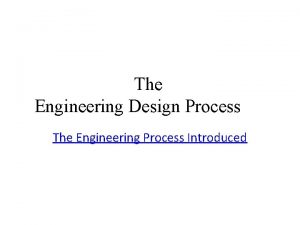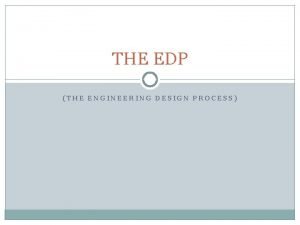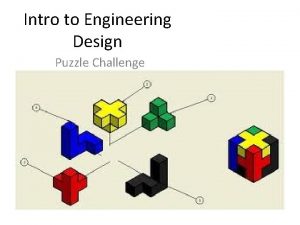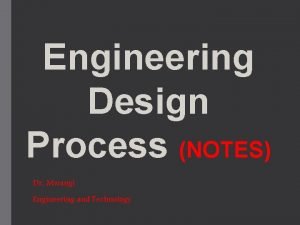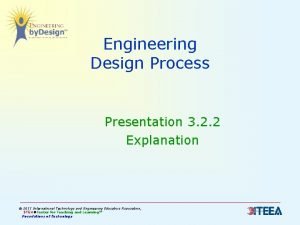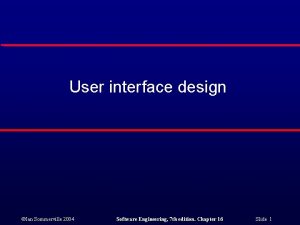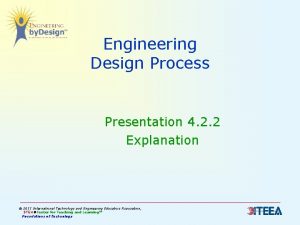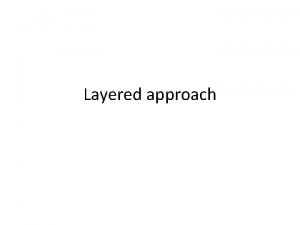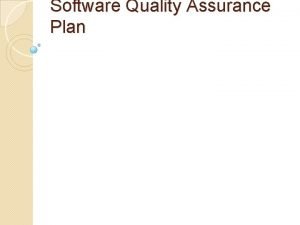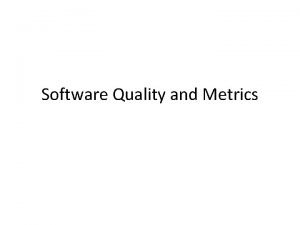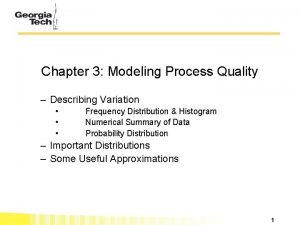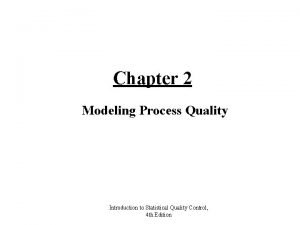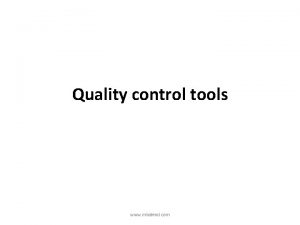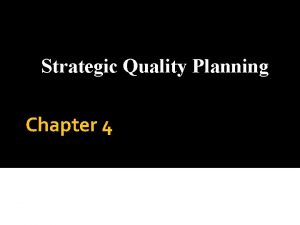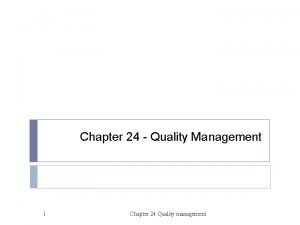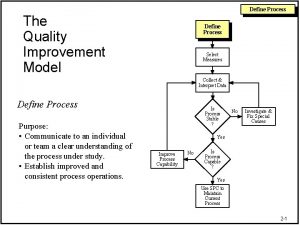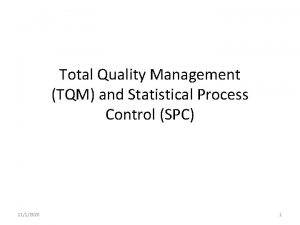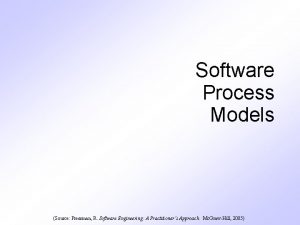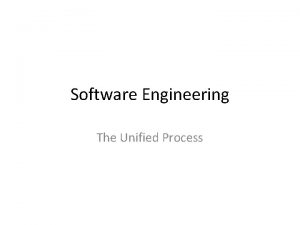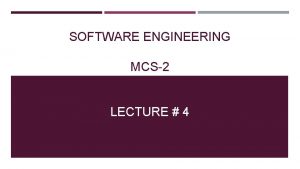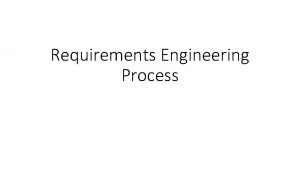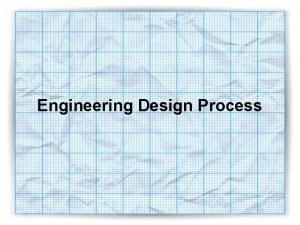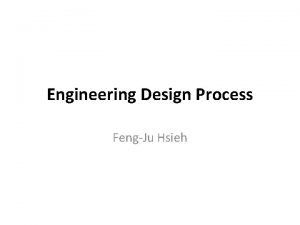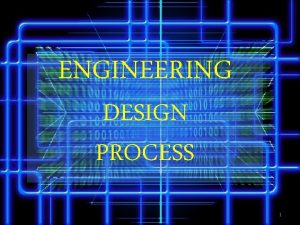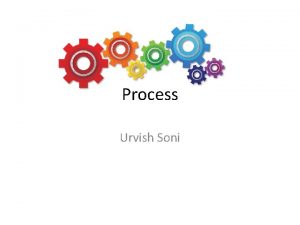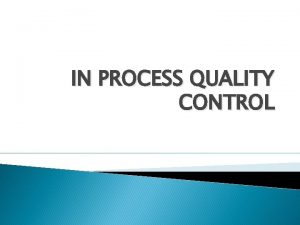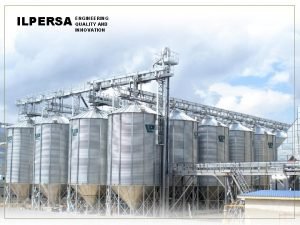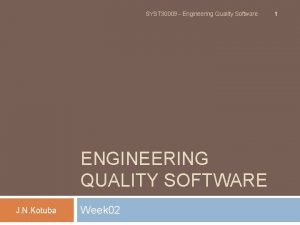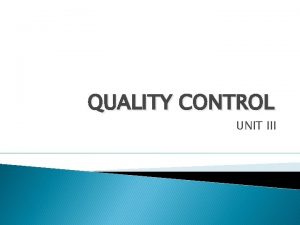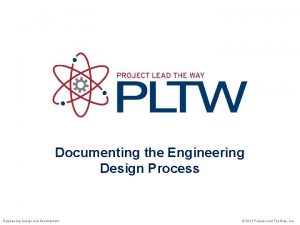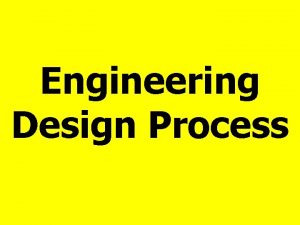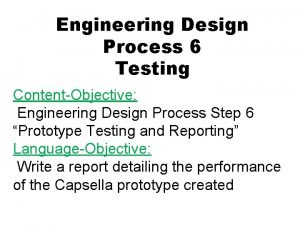UNIT III DESIGN ENGINEERING Design Process Design Quality

























![Refactoring • Fowler [FOW 99] defines refactoring in the following manner: – "Refactoring is Refactoring • Fowler [FOW 99] defines refactoring in the following manner: – "Refactoring is](https://slidetodoc.com/presentation_image_h2/7d47c1a44f7f373d0c33a395aa78def4/image-26.jpg)


















![Arch. Context Diagram [ACD] 45 Arch. Context Diagram [ACD] 45](https://slidetodoc.com/presentation_image_h2/7d47c1a44f7f373d0c33a395aa78def4/image-45.jpg)






















- Slides: 67

UNIT III – DESIGN ENGINEERING • Design Process & Design Quality, Design Concepts • Design Model: Data Design, Architectural Design , Interface Design & Component level elements • Architectural Design: Software Architecture, Architectural Styles, Architectural Design • User Interface Design : Rules, User Interface Analysis & Design • Applying Interface Design Steps, Issues • Web Application Interface Design Principles

DESIGN ENGINEERING 1. Commences after 1 st iteration of Requirements Analysis 2. GOAL : To create design model that will implement all customer requirements correctly to his satisfaction. 3. INTENT: To devlop High Quality Software by applying a set of principles, concepts and practices 4. COMPONENTS: • Data Structures Design • Architectural Design • Interface Design • Component Level Design

GENERIC TASK SET FOR DESIGN • Design appropriate Data Structures • Select appropriate architectural style • Partition Analysis Model into design subsystems • Create a set of Design Classes using design patterns • Interface design • Design User Interfaces • Conduct component level design • Design Deployment Model

DESIGN MODELING PRINCIPALS • Traceability to analysis model • Consider architecture of the system • Data design as important as processing • Interfaces (Int and Ext) must be designed • HCI as per needs of end user • Functionally Independent component design • Low coupling and high cohesion • KIS – easily understandable • Design iterations for greater simplicity

Analysis Design 5

Design Principles • • • The design process should not suffer from ‘tunnel vision. ’ The design should be traceable to the analysis model. The design should not reinvent the wheel. The design should “minimize the intellectual distance” [DAV 95] between the software and the problem as it exists in the real world. The design should exhibit uniformity and integration. The design should be structured to accommodate change. The design should be structured to degrade gently, even when aberrant data, events, or operating conditions are encountered. Design is not coding, coding is not design. The design should be assessed for quality as it is being created, not after the fact. The design should be reviewed to minimize conceptual 6 (semantic) errors.

Design and Quality • the design must implement all of the explicit requirements contained in the analysis model, and it must accommodate all of the implicit requirements desired by the customer. • the design must be a readable, understandable guide for those who generate code and for those who test and subsequently support the software. • the design should provide a complete picture of the software, addressing the data, functional, and behavioral domains from an implementation perspective. 7

Quality Guidelines • A design should exhibit an architecture that (1) has been created using recognizable architectural styles or patterns, (2) is composed of components that exhibit good design characteristics and (3) can be implemented in an evolutionary fashion – For smaller systems, design can sometimes be developed linearly. • A design should be modular; that is, the software should be logically partitioned into elements or subsystems • A design should contain distinct representations of data, architecture, interfaces, and components. • A design should lead to data structures that are appropriate for the classes to be implemented and are drawn from recognizable data patterns. 8

Quality Guidelines – contd. • A design should lead to components that exhibit independent functional characteristics. • A design should lead to interfaces that reduce the complexity of connections between components and with the external environment. • A design should be derived using a repeatable method that is driven by information obtained during software requirements analysis. • A design should be represented using a notation that effectively communicates its meaning. 9

Quality Attributes ( FURPS) • Functionality : Feature Sets, Security • Usability : easy to use, overall aesthetics, consistency, documentation • Reliability : frequency & severity of failure • Performance : time and space complexity • Supportability : extensibility, adaptability, serviceability, maintainability, compatibility, configurability

Design Concepts • abstraction • architecture : data, procedure, control : the overall structure of the software • patterns : “conveys the essence” of a proven design solution • modularity : compartmentalization of data and function • information hiding : controlled interfaces • functional independence : high cohesion and low coupling • refinement : elaboration of detail for all abstractions • refactoring : improve design without effecting 11 behavior

Design Concepts : Abstraction • When we consider a modular solution to any problem, many levels of abstraction can be posted. At the highest level of abstraction, a solution is stated in broad terms using the language of problem environment. At lower levels of abstraction, a more detailed description of the solution is provided. • There are two types of abstractions, procedural and data • For example, procedural : compute result sequence of instructions Data : subject wise marks obtained 12

Design Concepts : Abstraction • Abstraction – process – extracting essential details – entity – a model or focused representation • Information hiding – the suppression of inessential information • Encapsulation – process – enclosing items in a container – entity – enclosure that holds the items 13

Data Abstraction door manufacturer model number type swing direction inserts lights type number weight opening mechanism implemented as a data structure 14

Procedural Abstraction open details of enter algorithm implemented with a "knowledge" of the object that is associated with enter 15

Design Concepts : Architecture “The overall structure of the software and the ways in which that structure provides conceptual integrity for a system. ” [SHA 95 a] Structural properties : This aspect of the architectural design representation defines the components of a system (e. g. , modules, objects, filters) and the manner in which those components are packaged and interact with one another. For example, objects are packaged to encapsulate both data and the processing that manipulates the data and interact via the invocation of methods Extra-functional properties : The architectural design description should address how the design architecture achieves requirements for performance, capacity, reliability, security, adaptability, and other system characteristics. Families of related systems : The architectural design should draw upon repeatable patterns that are commonly encountered in the design of families of similar systems. In essence, the design should have the ability to reuse architectural building blocks. 16

Design Concepts : Patterns • A pattern for software architecture describes a particular recurring design problem that arises in specific design contexts, and presents a well-proven generic scheme for its solution. The solution scheme is specified by describing its constituent components, their responsibilities and relationships, and the ways in which they collaborate. 17

Patterns Design Pattern Template Pattern name—describes the essence of the pattern in a short but expressive name Intent—describes the pattern and what it does Also-known-as—lists any synonyms for the pattern Motivation—provides an example of the problem Applicability—notes specific design situations in which the pattern is applicable Structure—describes the classes that are required to implement the pattern Participants—describes the responsibilities of the classes that are required to implement the pattern Collaborations—describes how the participants collaborate to carry out their responsibilities Consequences—describes the “design forces” that affect the pattern and the potential trade-offs that must be considered when the pattern is implemented 18 Related patterns—cross-references related design patterns

Design Patterns • The best designers in any field have an uncanny ability to see patterns that characterize a problem and corresponding patterns that can be combined to create a solution • A description of a design pattern may also consider a set of design forces. – Design forces describe non-functional requirements (e. g. , ease of maintainability, portability) associated the software for which the pattern is to be applied. • The pattern characteristics (classes, responsibilities, and collaborations) indicate the attributes of the design that may be adjusted to enable the pattern to accommodate a variety of problems. 19

Patterns • An architectural pattern expresses a fundamental structural organization schema for software systems. It provides a set of predefined subsystems, specifies their responsibilities, and includes rules and guidelines for organizing the relationships between them. • A design pattern provides a scheme for refining the subsystems or components of a software system, or the relationships between them. It describes a commonly-recurring structure of communicating components that solves a general design problem within a particular context. • An idiom is a low-level pattern specific to a programming language. An idiom describes how to implement particular aspects of components or the relationships between them using the features of the given language. 20

Modularity: Trade-offs What is the "right" number of modules for a specific software design? module development cost of software module integration cost optimal number of modules 21

Information Hiding module • controlled interface • • • clients algorithm data structure details of external interface resource allocation policy "secret" a specific design decision 22

Why Information Hiding? • reduces the likelihood of “side effects” • limits the global impact of local design decisions • emphasizes communication through controlled interfaces • discourages the use of global data • leads to encapsulation—an attribute of high quality design • results in higher quality software 23

Stepwise Refinement open walk to door; reach for knob; open door; walk through; close door. repeat until door opens turn knob clockwise; if knob doesn't turn, then take key out; find correct key; insert in lock; endif pull/push door move out of way; end repeat 24

Functional Independence 25
![Refactoring Fowler FOW 99 defines refactoring in the following manner Refactoring is Refactoring • Fowler [FOW 99] defines refactoring in the following manner: – "Refactoring is](https://slidetodoc.com/presentation_image_h2/7d47c1a44f7f373d0c33a395aa78def4/image-26.jpg)
Refactoring • Fowler [FOW 99] defines refactoring in the following manner: – "Refactoring is the process of changing a software system in such a way that it does not alter the external behavior of the code [design] yet improves its internal structure. ” • When software is refactored, the existing design is examined for – redundancy – unused design elements – inefficient or unnecessary algorithms – poorly constructed or inappropriate data structures – or any other design failure that can be corrected to yield a better design. 26

Design Classes • User interface classes – define abstractions necessary for HCI. • Business domain classes – refinements of analysis classes. • Process classes – lower-level business abstractions that manage business domain classes. • Persistent classes – data stores (databases) that persist beyond execution of the software. • System classes – management and control functions that enable the system to operate and communicate within its computing environment and with the outside world. 27

Well-formed Design Class • Complete and sufficient – class should be a complete and sufficient encapsulation of reasonable attributes and methods. • Primitiveness – each method should be focused on one thing. • High cohesion – class should be focused on one kind of thing. • Low coupling – collaboration should be kept to an acceptable minimum. 28 Q

The Design Model 29

Design Model Elements • Data elements – Architectural level databases and files – Component level data structures • Architectural elements – An architectural model is derived from: • Application domain • Analysis model • Available styles and patterns • Interface elements – There are three parts to the interface design element: – The user interface (UI) – Interfaces to external systems – Interfaces to components within the application • Component elements • Deployment elements 30

Interface Elements 31

Deployment Diagram 32

Architectural Design Software Architecture • The software architecture of a program or computing system is the structure or structures of the system, which comprise the software components, the externally visible properties of those components, and the relationships among them. — Bass. et al. 33

Why Architecture? • Architecture is a representation of a system that enables the software engineer to: 1. analyze the effectiveness of the design in meeting its stated requirements, 2. consider architectural alternatives at a stage when making design changes is still relatively easy, and 3. reduce the risks associated with the construction of the software. 34

Data Design • Architectural level Database design – data mining – data warehousing • Component level Data structure design 35

Architectural Styles • Each style describes a system category that encompasses: 1. a set of components (e. g. , a database, computational modules) that perform a function required by a system, 2. a set of connectors that enable “communication, coordination, and cooperation” among components, 3. constraints that define how components can be integrated to form the system, and 4. semantic models that enable a designer to understand the overall properties of a system. 36

Specific Styles • • • Data-centered architecture Data flow architecture Call and return architecture Object-oriented architecture Layered architecture 37

Data-Centered Architecture 38

Data-Flow Architecture 39

Call and Return Architecture 40

Object-Oriented Architecture 41

Layered Architecture 42

Architectural Patterns • Concurrency – operating system process management – task scheduler • Persistence – database management system – application level persistence • Distribution – broker 43

Architectural Design • Architectural Context Diagrams (ACD) model how software interacts with external entities • Archetypes are classes or patterns that represent an abstraction critical to the system • Architectural components are derived from the application domain, the infrastructure, and the interface. • Instantiations of the system archtecture so far represented to reveal additional components if required 44
![Arch Context Diagram ACD 45 Arch. Context Diagram [ACD] 45](https://slidetodoc.com/presentation_image_h2/7d47c1a44f7f373d0c33a395aa78def4/image-45.jpg)
Arch. Context Diagram [ACD] 45

Safe. Home ACD 46

Safe. Home Archetype 47

Component Structure 48

Component Elaboration Instantiation 49

Interface Design Easy to learn? Easy to use? Easy to understand? 50

Interface Design Typical Design Errors lack of consistency too much memorization no guidance / help no context sensitivity poor response Arcane/unfriendly 51

Golden Rules • Place the user in control • Reduce the user’s memory load • Make the interface consistent 52

Place the User in Control 1. Define interaction modes in a way that does not force a user into unnecessary or undesired actions. 2. Provide for flexible interaction. 3. Allow user interaction to be interruptible and undoable. 4. Streamline interaction as skill levels advance and allow the interaction to be customized. 5. Hide technical internals from the casual user. 6. Design for direct interaction with objects that appear on the screen. 53

Reduce the User’s Memory Load 1. Reduce demand on short-term memory. 2. Establish meaningful defaults. 3. Define shortcuts that are intuitive. 4. The visual layout of the interface should be based on a real world metaphor. 5. Disclose information in a progressive fashion. 54

Make the Interface Consistent 1. Allow the user to put the current task into a meaningful context. 2. Maintain consistency across a family of applications. 3. If past interactive models have created user expectations, do not make changes unless there is a compelling reason to do so. 55

User Interface Design Models • User model — a profile of all end users of the system • Design model — a design realization of the user model • Mental model (system perception) — the user’s mental image of what the interface is • Implementation model — the interface “look and feel” coupled with supporting information that describe interface syntax and semantics 56

User Interface Design Process 57

Interface Analysis • Interface analysis means understanding – (1) the people (end-users) who will interact with the system through the interface; – (2) the tasks that end-users must perform to do their work, – (3) the content that is presented as part of the interface – (4) the environment in which these tasks will be conducted. 58

User Analysis 1. Are users trained professionals, technician, clerical, or manufacturing workers? 2. What level of formal education does the average user have? 3. Are the users capable of learning from written materials or have they expressed a desire for classroom training? 4. Are users expert typists or keyboard phobic? 5. What is the age range of the user community? 59

User Analysis – contd. 7. How are users compensated for the work they perform? 8. Do users work normal office hours or do they work until the job is done? 9. Is the software to be an integral part of the work users do or will it be used only occasionally? 10. What is the primary spoken language among users? 11. What are the consequences if a user makes a mistake using the system? 12. Are users experts in the subject matter that is addressed by the system? 13. Do users want to know about the technology the 60 sits behind the interface?

Task Analysis and Modeling • Task Analysis answers the following questions … – What work will the user perform in specific circumstances? – What tasks and subtasks will be performed as the user does the work? – What specific problem domain objects will the user manipulate as work is performed? – What is the sequence of work tasks—the workflow? – What is the hierarchy of tasks? • Use-cases define basic interaction • Task elaboration refines interactive tasks • Object elaboration identifies interface objects (classes) • Workflow analysis defines how a work process is completed when several people (and roles) are involved 61

Swimlane Diagram 62

Analysis of Display Content 1. Are different types of data assigned to consistent geographic locations on the screen (e. g. , photos always appear in the upper right hand corner)? 2. Can the user customize the screen location for content? 3. Is proper on-screen identification assigned to all content? 4. If a large report is to be presented, how should it be partitioned for ease of understanding? 5. Will mechanisms be available for moving directly to summary information for large collections of data. 6. Will graphical output be scaled to fit within the bounds of the display device that is used? 7. How will color to be used to enhance understanding? 8. How will error messages and warning be presented to the user? 63

Interface Design Steps • Using information developed during interface analysis (SEPA, Section 12. 3), define interface objects and actions (operations). • Define events (user actions) that will cause the state of the user interface to change. Model this behavior. • Depict each interface state as it will actually look to the end-user. • Indicate how the user interprets the state of the system from information provided 64

Interface Design Patterns • Patterns are available for – The complete UI – Page layout – Forms and input – Tables – Direct data manipulation – Navigation – Searching – Page elements www. hcipatterns. org – e-Commerce 65

Interface Design Issues • • • Response time Help facilities Error handling Menu and command labeling Application accessibility Internationalization 66

Interface Design Evaluation Cycle 67
 Hamlet act iii scene iii
Hamlet act iii scene iii Quality design process
Quality design process Quality and innovation in product and process design
Quality and innovation in product and process design Unit 10, unit 10 review tests, unit 10 general test
Unit 10, unit 10 review tests, unit 10 general test Unit process and unit operation
Unit process and unit operation Difference between unit process and unit operation
Difference between unit process and unit operation Quality control and quality assurance
Quality control and quality assurance Pmp quality vs grade
Pmp quality vs grade Pmbok quality management
Pmbok quality management Define quality assurance in nursing
Define quality assurance in nursing Quality improvement vs quality assurance
Quality improvement vs quality assurance Basic concepts of quality control
Basic concepts of quality control Which one is jurans three role model
Which one is jurans three role model Crosby quality is free
Crosby quality is free Old quality vs new quality
Old quality vs new quality Unit 4 engineering design
Unit 4 engineering design Engineering design process quiz answers
Engineering design process quiz answers Basic engineering design process
Basic engineering design process What are the steps for the engineering design process
What are the steps for the engineering design process 10 steps of engineering design process
10 steps of engineering design process 7 steps of the design process
7 steps of the design process Engineering design process
Engineering design process Stages of engineering
Stages of engineering Engineering design process song
Engineering design process song Design process in software engineering
Design process in software engineering The 10 steps of the engineering design process
The 10 steps of the engineering design process Engineering design process
Engineering design process Edp engineering design process
Edp engineering design process Engineering cube puzzle
Engineering cube puzzle Design process notes
Design process notes Scientific method vs engineering design process
Scientific method vs engineering design process User interface design process in software engineering
User interface design process in software engineering Interface design in software engineering
Interface design in software engineering Scientific method vs engineering design process
Scientific method vs engineering design process Interface analysis means understanding
Interface analysis means understanding Quality methods and tools
Quality methods and tools Statistical quality assurance in software engineering
Statistical quality assurance in software engineering What is software quality assurance plan
What is software quality assurance plan Quality metrics in software engineering
Quality metrics in software engineering What is system in software engineering
What is system in software engineering Forward engineering and reverse engineering
Forward engineering and reverse engineering Engineering elegant systems: theory of systems engineering
Engineering elegant systems: theory of systems engineering Elegant systems
Elegant systems Reverse engineering vs forward engineering
Reverse engineering vs forward engineering Unit 5 quality of mercy
Unit 5 quality of mercy Certified quality process analyst
Certified quality process analyst Quality alert process
Quality alert process Types of metrics software
Types of metrics software Modeling process quality
Modeling process quality Modeling process quality
Modeling process quality Mbaknol.com
Mbaknol.com Strategic quality planning
Strategic quality planning Process quality management
Process quality management Define process quality
Define process quality Grandfather of tqm
Grandfather of tqm Certified quality process analyst
Certified quality process analyst Btec sport practical
Btec sport practical Btec level 3 engineering unit 1 past papers
Btec level 3 engineering unit 1 past papers Unit 2 communications for engineering technicians
Unit 2 communications for engineering technicians Web engineering process
Web engineering process Software process models
Software process models Unified engineering software
Unified engineering software Prototyping process in software engineering
Prototyping process in software engineering Process and project metrics in software engineering
Process and project metrics in software engineering Domain requirements examples
Domain requirements examples A spiral view of the requirements engineering process
A spiral view of the requirements engineering process System engineering process
System engineering process Quality contract review
Quality contract review

